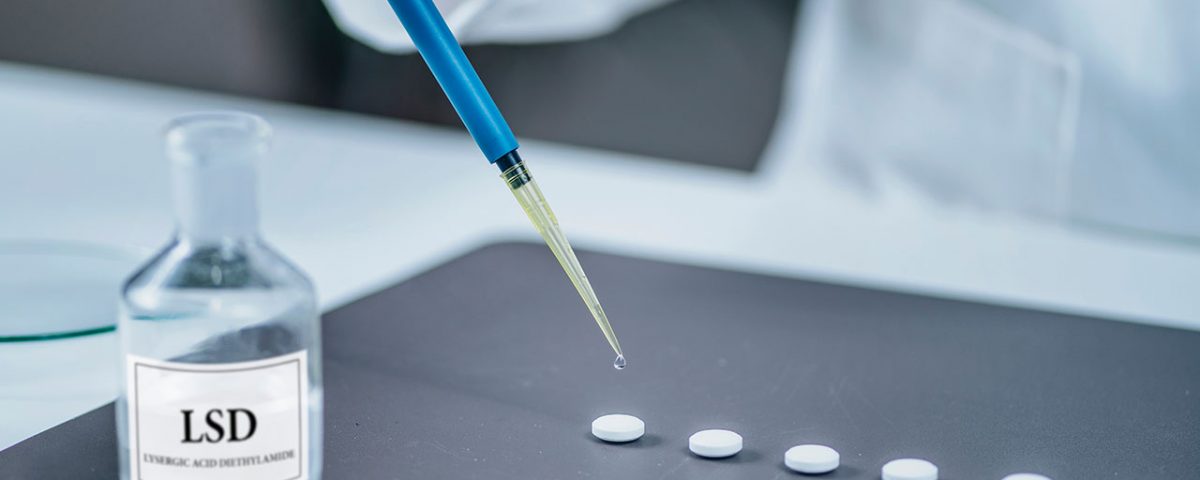While some people report having great experiences when taking this combination, taking either drug alone can be dangerous, so imagine what combining them can do. The desire to enhance the effects of a substance by combining it with another is a serious red flag that should be heavily considered by the user and their loved ones. Today, our Chicago drug rehab is sharing the side effects of taking Molly and acid together and why candy flipping is not as sweet as it sounds.
MDMA vs. LSD
People often confuse LSD and MDMA or use their names interchangeably. These two drugs are commonly used for recreational purposes, especially in social settings. While the two may seem similar, understanding what makes them different can give you a better idea of why candy-flipping is dangerous.
What Is MDMA?
3,4-methylenedioxymethamphetamine (MDMA) is a synthetic drug that acts as a stimulant and hallucinogen, which means it produces both increased energy and enhanced sensory experiences. Otherwise referred to as ecstasy or Molly, MDMA has also been referred to as an entactogen, which is a drug known to increase self-awareness and empathy in users.
Ecstasy is the name for the tablet form of MDMA, which is the most common way people take it. Like many other drugs of abuse, ecstasy often contains other harmful chemicals or cutting agents in addition to MDMA, increasing the user’s risk of adverse side effects. For instance, other drugs like methamphetamine, ketamine, caffeine, ephedrine, dextromethorphan, phencyclidine (PCP), cocaine, and heroin have been found in ecstasy tablets.
Molly, on the other hand, refers to the crystalline powder form of MDMA, which is usually sold as a powder or in capsules that are taken orally. Like ecstasy, Molly has been known to contain other drugs aside from MDMA, including methylone, a synthetic stimulant commonly found in a drug called bath salts.
Common street names for ecstasy (MDMA) include:
- Molly
- E
- XTC
- Adam
- Beans
- Candy
- Rolls
- X
- Love drug
- Hug drug
- E-bomb
- Scooby snacks
- Thizz
- Skittles
- Disco biscuits
- Smarties
- Cadillac
- Tesla
- Superman
Common side effects of MDMA include increased alertness, a sense of well-being, euphoria, emotional warmth, increased empathy towards others, and impaired judgment. However, not everyone has pleasant experiences when taking ecstasy, and some may even experience adverse effects like involuntary jaw clenching, lack of appetite, depersonalization, disorganized thoughts, restless leg syndrome, and nausea.
What Is LSD?
Lysergic acid diethylamide (LSD) is a synthetic drug that’s made from ergot, a type of fungus that grows on rye (grain). LSD belongs to a group of drugs called psychedelics. Other types of psychedelics include ayahuasca, DMT, and Psilocybin (magic mushrooms).
When taken in small doses, LSD can produce minor changes in perception, mood, and thinking. However, larger doses may lead to side effects like visual and auditory hallucinations and a distorted sense of space and time.
Common street names for LSD include:
- Acid
- Lucy
- Tabs
- Trips
- Hits
- Doses
- Blotter
- Paper
- Sunshine
- Electric Kool-Aid
- Alice
- Sugar cubes
- Microdots
- California sunshine
- Purple haze
- Windowpane
- Zen
- Dots
- Heavenly blue
When it’s pure, LSD is a white and odorless crystalline powder but can be sold as a liquid, tablet, or in capsules. Because it’s so potent, only small amounts are needed to produce a high. As a result, sellers usually dilute the drug in liquids that can be dried onto gelatin sheets, blotting paper, or sugar cubes.
Common side effects of LSD include euphoria, dilated pupils, confusion, trouble concentrating, rapid breathing, nausea, and visual and auditory hallucinations. If a person takes too much or overdoses on acid, they may experience more severe effects like panic, paranoia, and psychosis.
Like MDMA, other chemicals like NBOMe (N-methoxybenzyl) are sold as acid instead of the real thing. As a result, there’s no way to gauge how much is being used or what side effects will be like, increasing a user’s risk for a bad trip and intoxication.
Additionally, toxicity may occur when high doses are taken or when the drug is mixed with other substances and can be fatal. These chemicals are also habit-forming and can lead to physical dependence and addiction.
What Is Candy Flipping?
Candy flipping, candy-flipping, or candyflipping is the practice of mixing LSD and MDMA to produce a more intense high. Usually, people who are candy-flipping will start by taking LSD and then take MDMA about 4 hours later.
This timeline allows them to feel the peak effects of LSD, such as euphoria and elevated mood, before adding the additional side effects of Molly. However, while the MDMA-LSD combo sounds like a good time, the pleasure of the experience is short-lived compared to its dangers.
Candy Flip Effects
It’s hard to say, simply because the individual side effects of LSD and ecstasy vary every time they’re used, even if the same doses are taken. However, we will say that candyflipping produces side effects of both drugs. Some older studies on candyflipping also suggest that the combination produces intense MDMA-like side effects and not so many acid side effects.1 However, people who have taken the combination say that you experience equal parts of both drugs.
Others say that sometimes taking MDMA rekindles the effects of an acid trip, which can be either very good or very bad. LSD is known to either cause good trips or bad trips. While good trips may produce euphoria, bad trips are characterized by paranoia, disturbing hallucinations, anxiety, and other uncomfortable symptoms.
Therefore, it’s safe to say that the side effects of candyflipping include:
- Euphoria
- Increased energy
- Elevated heart rate and blood pressure
- Dehydration
- Distorted sense of time and environment
- Visual and auditory hallucinations (seeing and hearing things that aren’t real)
- Mood swings
- Paranoia
- Confusion
- Dizziness
- Fear and anxiety
- Increased empathy
- Impaired judgment
- Increased sensitivity to touch
- Muscle cramping
- Chills
- Excessive sweating
- Involuntary teeth clenching
- Sweating
- Elevated body temperature
The complex and unpredictable nature of combining MDMA and LSD in candyflipping makes it challenging to definitively outline the specific side effects, as individual reactions can vary widely. Although some research points to a preference for strong MDMA-like effects over acid-related ones, user reports point to a more balanced combination of the two. Most importantly, the candyflipping experience is made even more unpredictable by the intrinsic duality of LSD, which can cause either positive or unpleasant experiences.
People must approach these pairings cautiously, understanding that there could be dangerous results. To minimize hazards and guarantee a safer psychedelic experience, candyflipping participants should reconsider this choice. As one of Banyan’s esteemed Illinois rehabs, we have seen firsthand the damage that drug abuse can lead to.
How Long Do Candy Flipping Effects Last?
How long candyflipping effects last is hard to determine because research on this practice is limited, and any research on the topic is from the 80s and 90s when it first became popular. However, we can offer an estimate by looking at how long the effects of Molly and acid last.
LSD kicks in within 30 to 60 minutes after it’s taken and can produce side effects that can last as long as 12 hours, sometimes even longer, depending on how much the person took.2 MDMA, which is usually taken a few hours after LSD, usually kicks in within 20 to 70 minutes and lasts for about 3 to 6 hours.3
When you put these two together, the candyflipping experience can last anywhere from 12 to 24 hours, not including any aftereffects. It’s important to keep in mind that acid often remains stored in the body’s fat, allowing it to continue producing side effects even months after it was last taken.
Candy Flipping Comedown
Because both LSD and MDMA can produce an unpleasant comedown, it’s safe to say that mixing them will do the same thing.
An LSD comedown usually lasts about 24 hours and may include symptoms like depression, panic, and paranoia. Some users have also reported having these symptoms for days or months after they last used LSD.
The comedown from MDMA can be more severe, producing similar symptoms as an LSD comedown, as well as a craving or urge to take MDMA again.
Together, LSD and MDMA can produce comedown effects like:
- Difficulty concentrating
- Problems with memory
- Irritability and aggression
- Decreased appetite
- Depression
- Panic
- Paranoia
- Cravings for MDMA
- Reduced libido or sex drive
- Erectile dysfunction (for men)
It's critical to put harm reduction techniques, mental health, and self-care first while users move through this comedown phase. For those who decide to partake in these experiences, they must comprehend the possible outcomes and be ready for the fallout. Encouraging a safer and better-informed interaction with psychoactive substances requires responsible usage, education, and an awareness of one's own limitations.
Why Might Someone Attempt Flipping Candy?
People might attempt candy-flipping for a variety of reasons, seeking a unique and intensified sensory experience from the combination of acid and Molly. While LSD produces hallucinations and changes perception, MDMA is well known for its euphoric and empathogenic effects, which foster feelings of love and connection. When two drugs are combined, they can have a synergistic impact that amplifies the benefits of each one. Candy-flipping may be pursued by people who want to experience a more profound euphoria, enhanced auditory perception, a stronger emotional bond, and a deeper appreciation of music.
Furthermore, some people can be lured to candy-flipping as a way to have spiritual or self-discovery experiences. The hallucinogenic effects of LSD combined with the emotional openness of MDMA can induce profound introspection and a sensation of oneness with the universe. It's important to remember that mixing Molly and acid entails hazards as well, including a higher chance of unfavorable side effects like anxiety, paranoia, and physical discomfort. Candy-flipping or any other combination of substances requires responsible use, knowledge of one's tolerance, and awareness of potential consequences.
The Pervasive Dangers and Red Flags of Polysubstance Abuse
Candy flipping is a prime example of polysubstance abuse, a phrase used to describe the simultaneous or concurrent use of several drugs or alcohol, frequently in combination. This harmful practice increases the possibility of negative repercussions and complications and poses serious hazards to people's bodily and mental health. Promoting prevention, intervention, and support requires an awareness of the ubiquitous risks and warning signs of polydrug use.
First, the risk of overdose is heightened. The body's ability to metabolize and discard these chemicals can be overpowered by their combined effects on the central nervous system, which could lead to situations where life is in danger. This combination can also exacerbate negative health effects. The heart and circulatory system are put under stress when these substances are combined with alcohol or stimulants, for instance, and respiratory depression and an increased risk of organ failure can result when they are combined with depressants like opioids or benzodiazepines.
Some of the signs of polysubstance abuse, like candy flipping, include:
- Frequent and excessive usage of LSD, MDMA, and other drugs.
- Drastic alterations in attitude, appearance, or behavior while under the influence.
- Neglecting obligations at work, school, or home because of substance abuse.
- Harmful behaviors when under the influence, such as unsafe sex or driving.
- Financial challenges or unexplainable financial stress connected to purchasing drugs.
- Relationship issues and social isolation brought on by drug use.
- Physical indicators like tremors, dilated pupils, or inexplicable wounds.
- Seeking LSD, MDMA, and other drugs from many sources or conversing about substances in coded language.
Candy flipping is a poignant example of polysubstance misuse, which is the dangerous behavior of consuming numerous drugs or alcohol at once. Early intervention depends on heightened awareness of warning indicators, which include frequent and heavy drug use, abrupt behavioral changes, and abandonment of obligations. Preventive measures and support systems are necessary because of the possibility of hazardous behaviors and strained relationships. Encouraging education, encouraging candid communication, and offering easily accessible options for intervention and treatment are crucial measures in preventing the risks associated with polysubstance addiction and protecting people's physical and mental health.
What Are the Warning Signs of LSD or MDMA Addiction?
When considering the possibility of addiction to substances such as LSD or MDMA, it's important to recognize certain indicative signs. These signs not only reflect the physical and psychological grip of the substances but also their pervasive impact on daily functioning and relationships. Here are key indicators that someone might be struggling with such an addiction:
1. Prioritization of substance use over daily activities and responsibilities: An individual may allocate significant amounts of time to obtaining, using, or recovering from the effects of the substance, often at the expense of professional obligations, educational pursuits, or family commitments.
2. Continued use despite adverse consequences: Persisting in substance use even when facing serious repercussions such as legal challenges, professional setbacks like job loss, or personal losses, including the deterioration of relationships and parental rights.
3. Physical signs and changes in health: Depending on the substance, one might notice a decline in personal grooming, erratic sleeping patterns, and unexplained weight fluctuations.
4. Legal problems: Frequent encounters with the law can be a sign, whether these involve arrest records related to disorderly conduct, altercations, or DUIs.
5. Financial difficulties: Financial instability may arise as funds are increasingly diverted towards sustaining the addiction, often leading to debt or a lack of money for basic necessities.
6. Increased tolerance and withdrawal avoidance: A notable increase in the amount of the substance needed to achieve desired effects, alongside use of the substance to stave off withdrawal symptoms, signifies escalating dependence.
7. Behavioral and psychological changes: There might be noticeable shifts in demeanor, emotional stability, and overall motivation, which can affect all areas of life from work performance to interpersonal relationships.
Recognizing these warning signs can be the first step towards seeking necessary help and recovery options.
The Bottom Line
Candyflipping isn’t as innocent or sweet as it sounds. In addition to the unpleasant side effects we mentioned above, there’s also the risk of overdosing on MDMA when you candy-flip.
LSD can enhance the effects of Molly, not only contributing to a bad trip and paranoia but also increasing the likelihood of dehydration and heatstroke, both of which are linked to most ecstasy-related deaths. However, people who take too much Molly are also at an increased risk of water intoxication, which happens when you drink water too fast. Taking the two together can also lead to a bad trip, which can be even more unpleasant for someone with an underlying mental health condition.
Drug abuse of any kind can also lead to addiction, and drugs like MDMA and LSD can serve as gateway drugs to more harmful substances like cocaine or meth. If you’re currently struggling with drug use, our Illinois drug rehab offers resources that can help.
In addition to offering medically monitored detox at our sister facility, Banyan Heartland, we also provide PHP treatment at our Chicago addiction treatment center that helps patients focus on their recovery while remaining active in school, work, and at home.
If you’re interested in the other levels of substance abuse treatment offered at our drug rehab in Chicago, call Banyan Treatment Centers today at 888-280-4763.
Source:









